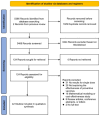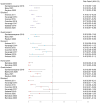The Clinical Effectiveness of Single-Dose Human Papillomavirus Vaccination
- PMID: 39339988
- PMCID: PMC11436243
- DOI: 10.3390/vaccines12090956
The Clinical Effectiveness of Single-Dose Human Papillomavirus Vaccination
Abstract
The human papillomavirus (HPV) vaccine was initially approved for a three-dose regimen. Due to resource limitations, budget constraints, low acceptance, and poor adherence, global vaccination coverage is only 15%. A single-dose regimen could simplify logistics, reduce costs, and improve accessibility. However, its clinical effectiveness remains debatable. This review systematically searched PubMed, Embase, and Cochrane Library, including 42 clinical studies, to assess the effectiveness of a single-dose HPV vaccination for preventing HPV infections, cervical abnormalities, and genital warts. We summarized the effectiveness of bivalent, quadrivalent, and nonavalent vaccines across different age groups and buffer periods, and analyzed the factors contributing to the inconsistency of results. The review also provides insights into designing robust future research to inform single-dose HPV vaccination policies and guidelines, highlighting the need for further research to refine vaccination strategies.
Keywords: dose; effectiveness; human papillomavirus; vaccine.
Conflict of interest statement
The authors declare no conflicts of interest.
Figures









Similar articles
-
Public health impact and cost-effectiveness of switching from bivalent to nonavalent vaccine for human papillomavirus in Norway: incorporating the full health impact of all HPV-related diseases.J Med Econ. 2023 Jan-Dec;26(1):1085-1098. doi: 10.1080/13696998.2023.2250194. J Med Econ. 2023. PMID: 37608730
-
Clinical and economic impact of school-based nonavalent human papillomavirus vaccine on women in Singapore: a transmission dynamic mathematical model analysis.BJOG. 2018 Mar;125(4):478-486. doi: 10.1111/1471-0528.15106. BJOG. 2018. PMID: 29266694
-
Cost-effectiveness analysis of the nonavalent human papillomavirus vaccine for the prevention of cervical cancer in Singapore.Vaccine. 2021 Apr 15;39(16):2255-2263. doi: 10.1016/j.vaccine.2021.03.040. Epub 2021 Mar 18. Vaccine. 2021. PMID: 33744050
-
Human Papillomavirus Vaccine Efficacy and Effectiveness against Cancer.Vaccines (Basel). 2021 Nov 30;9(12):1413. doi: 10.3390/vaccines9121413. Vaccines (Basel). 2021. PMID: 34960159 Free PMC article. Review.
-
Cervical cancer prevention by vaccination: review.Front Oncol. 2024 Apr 23;14:1386167. doi: 10.3389/fonc.2024.1386167. eCollection 2024. Front Oncol. 2024. PMID: 38715779 Free PMC article. Review.
References
Publication types
Grants and funding
LinkOut - more resources
Full Text Sources

